Global Finance: An Analysis of Dividend Policies in Indian Companies
VerifiedAdded on 2021/04/21
|7
|1911
|63
Report
AI Summary
This report delves into the critical issue of corporate dividend policy within the realm of global finance. It addresses fundamental questions such as dividend payout levels, the impact of dividend policies on firm valuation, and the alignment of dividend decisions with financing and investment activities. The report reviews existing literature, including contributions from Lintner, Miller and Modigliani, and others, to provide a comprehensive overview of the topic. The study focuses on analyzing the dividend policies of various Indian companies, employing a dataset of over 15 financial variables. It explores the influence of factors like earnings, agency costs, and institutional ownership on dividend decisions. The report is structured to include a literature review, hypothesis testing, results discussion, and conclusions, offering a detailed examination of dividend behavior and its determinants within the Indian corporate landscape. It aims to contribute to the understanding of dividend policy by providing an analysis of the latest data and insights on the factors influencing dividend decisions.
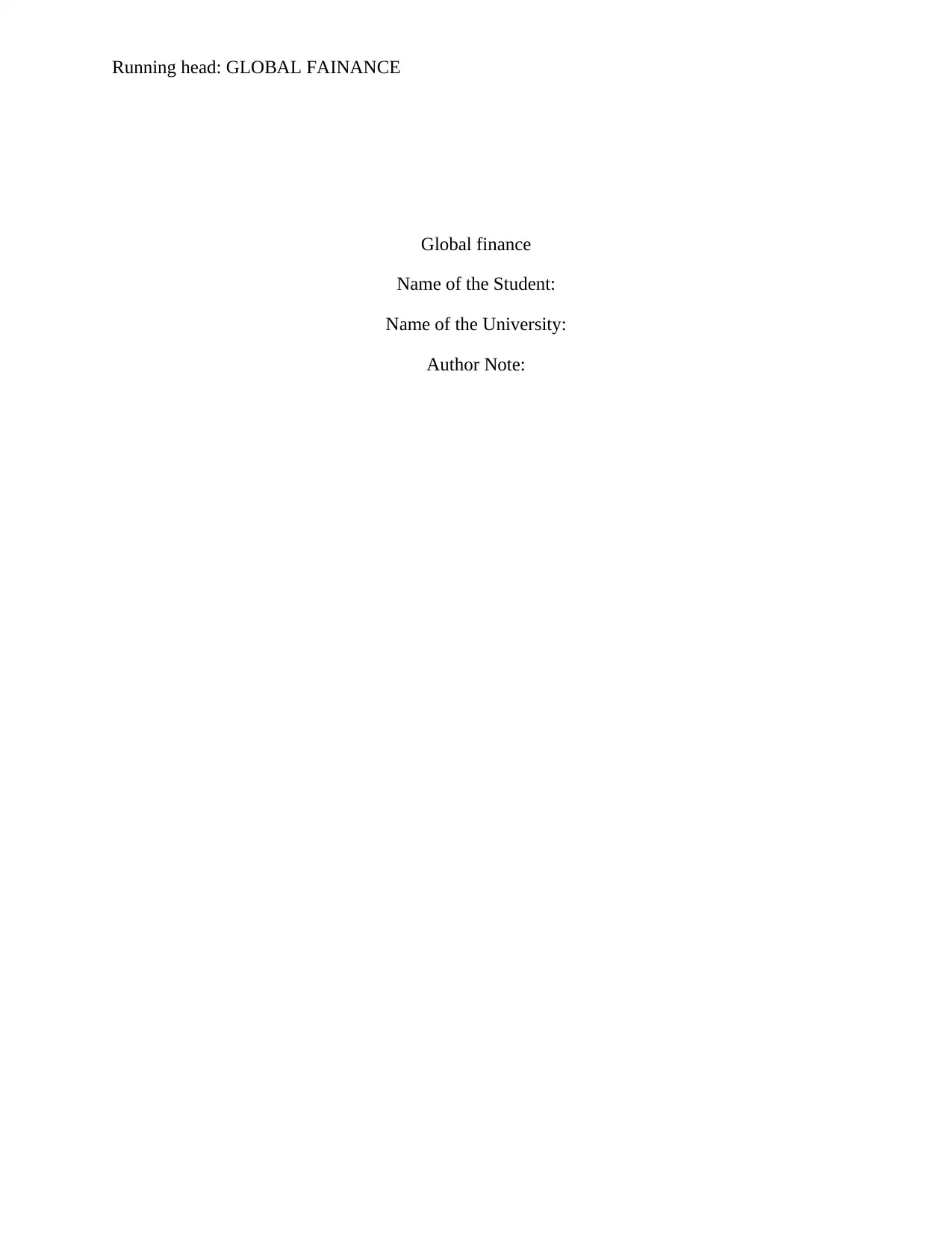
Running head: GLOBAL FAINANCE
Global finance
Name of the Student:
Name of the University:
Author Note:
Global finance
Name of the Student:
Name of the University:
Author Note:
Secure Best Marks with AI Grader
Need help grading? Try our AI Grader for instant feedback on your assignments.
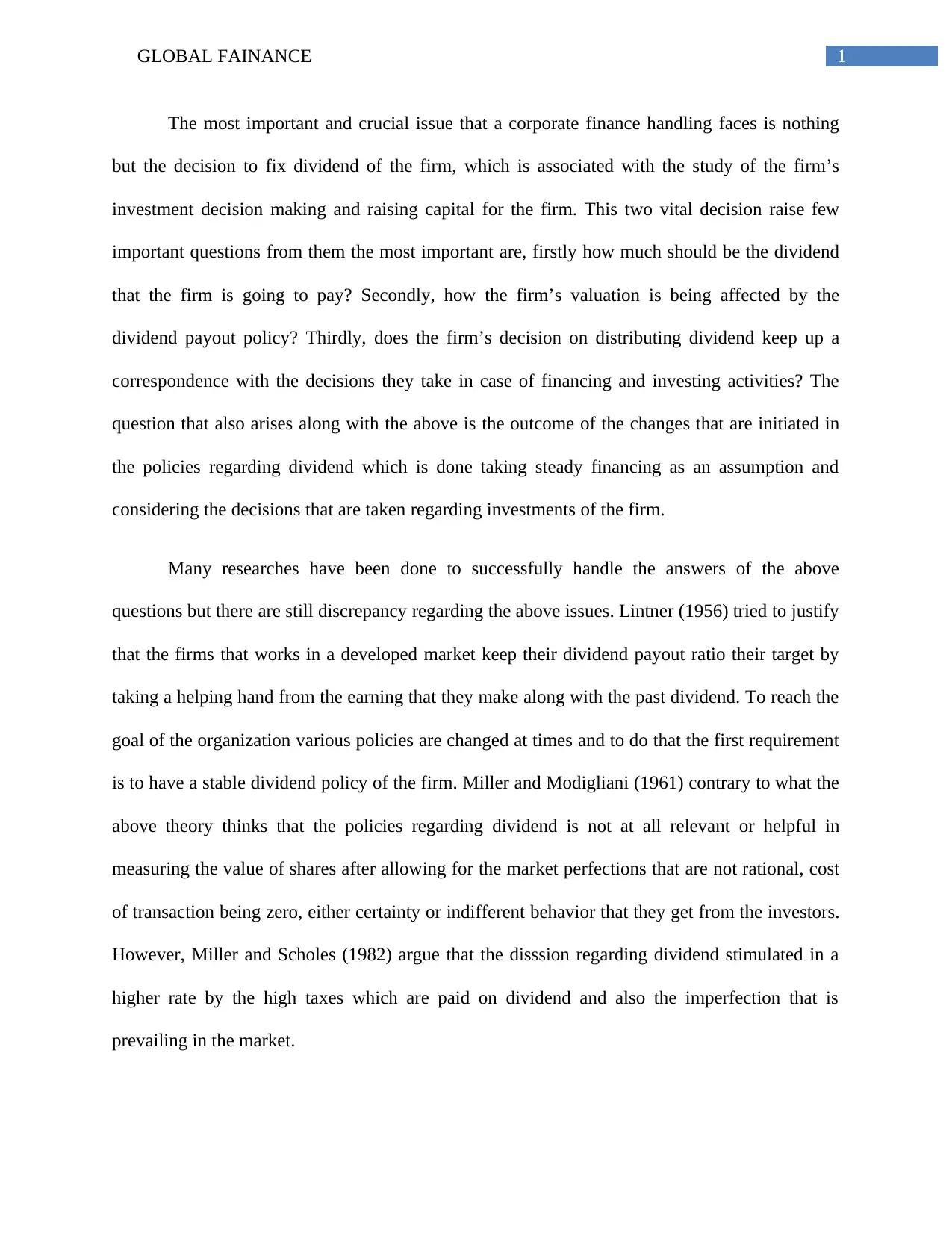
1GLOBAL FAINANCE
The most important and crucial issue that a corporate finance handling faces is nothing
but the decision to fix dividend of the firm, which is associated with the study of the firm’s
investment decision making and raising capital for the firm. This two vital decision raise few
important questions from them the most important are, firstly how much should be the dividend
that the firm is going to pay? Secondly, how the firm’s valuation is being affected by the
dividend payout policy? Thirdly, does the firm’s decision on distributing dividend keep up a
correspondence with the decisions they take in case of financing and investing activities? The
question that also arises along with the above is the outcome of the changes that are initiated in
the policies regarding dividend which is done taking steady financing as an assumption and
considering the decisions that are taken regarding investments of the firm.
Many researches have been done to successfully handle the answers of the above
questions but there are still discrepancy regarding the above issues. Lintner (1956) tried to justify
that the firms that works in a developed market keep their dividend payout ratio their target by
taking a helping hand from the earning that they make along with the past dividend. To reach the
goal of the organization various policies are changed at times and to do that the first requirement
is to have a stable dividend policy of the firm. Miller and Modigliani (1961) contrary to what the
above theory thinks that the policies regarding dividend is not at all relevant or helpful in
measuring the value of shares after allowing for the market perfections that are not rational, cost
of transaction being zero, either certainty or indifferent behavior that they get from the investors.
However, Miller and Scholes (1982) argue that the disssion regarding dividend stimulated in a
higher rate by the high taxes which are paid on dividend and also the imperfection that is
prevailing in the market.
The most important and crucial issue that a corporate finance handling faces is nothing
but the decision to fix dividend of the firm, which is associated with the study of the firm’s
investment decision making and raising capital for the firm. This two vital decision raise few
important questions from them the most important are, firstly how much should be the dividend
that the firm is going to pay? Secondly, how the firm’s valuation is being affected by the
dividend payout policy? Thirdly, does the firm’s decision on distributing dividend keep up a
correspondence with the decisions they take in case of financing and investing activities? The
question that also arises along with the above is the outcome of the changes that are initiated in
the policies regarding dividend which is done taking steady financing as an assumption and
considering the decisions that are taken regarding investments of the firm.
Many researches have been done to successfully handle the answers of the above
questions but there are still discrepancy regarding the above issues. Lintner (1956) tried to justify
that the firms that works in a developed market keep their dividend payout ratio their target by
taking a helping hand from the earning that they make along with the past dividend. To reach the
goal of the organization various policies are changed at times and to do that the first requirement
is to have a stable dividend policy of the firm. Miller and Modigliani (1961) contrary to what the
above theory thinks that the policies regarding dividend is not at all relevant or helpful in
measuring the value of shares after allowing for the market perfections that are not rational, cost
of transaction being zero, either certainty or indifferent behavior that they get from the investors.
However, Miller and Scholes (1982) argue that the disssion regarding dividend stimulated in a
higher rate by the high taxes which are paid on dividend and also the imperfection that is
prevailing in the market.
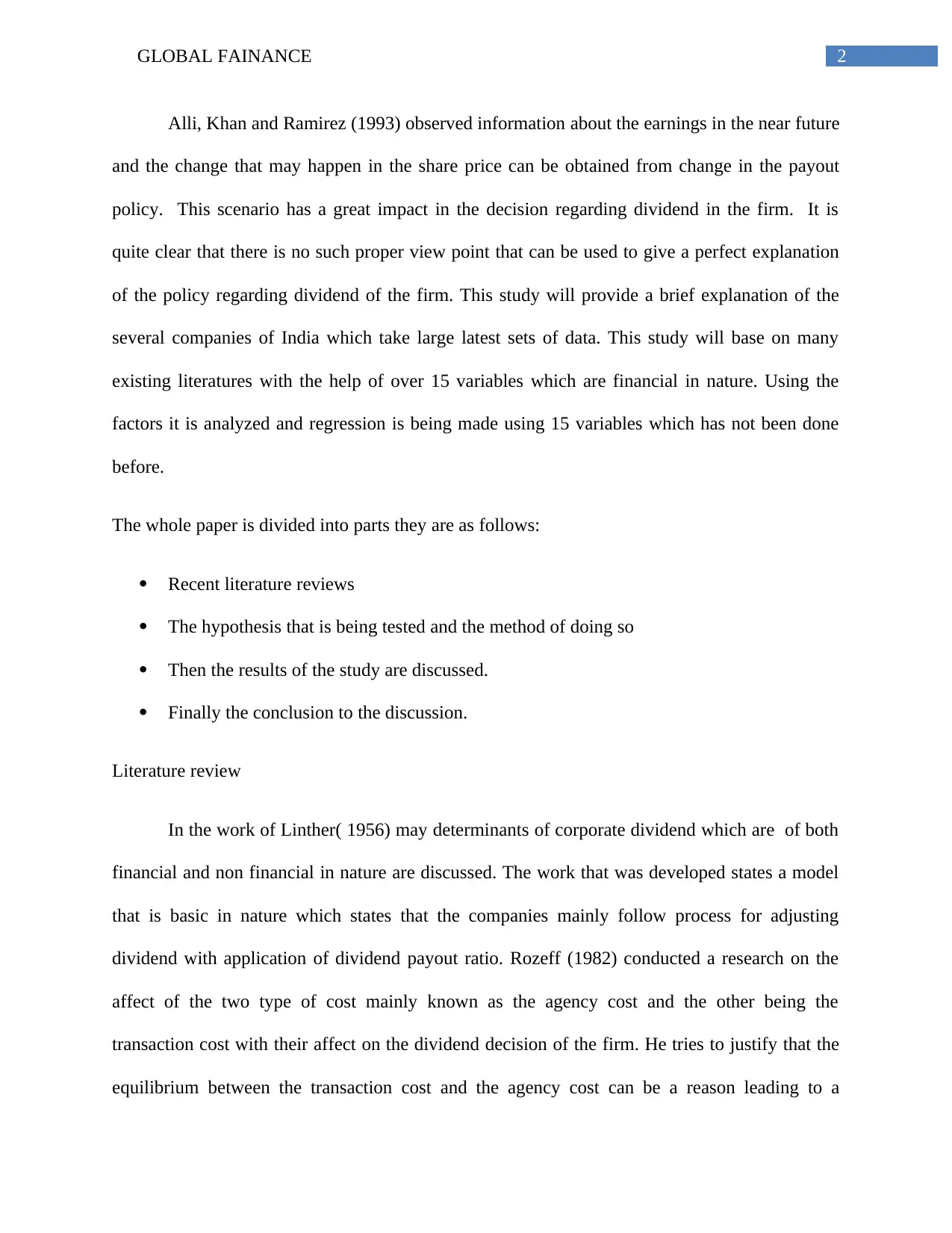
2GLOBAL FAINANCE
Alli, Khan and Ramirez (1993) observed information about the earnings in the near future
and the change that may happen in the share price can be obtained from change in the payout
policy. This scenario has a great impact in the decision regarding dividend in the firm. It is
quite clear that there is no such proper view point that can be used to give a perfect explanation
of the policy regarding dividend of the firm. This study will provide a brief explanation of the
several companies of India which take large latest sets of data. This study will base on many
existing literatures with the help of over 15 variables which are financial in nature. Using the
factors it is analyzed and regression is being made using 15 variables which has not been done
before.
The whole paper is divided into parts they are as follows:
Recent literature reviews
The hypothesis that is being tested and the method of doing so
Then the results of the study are discussed.
Finally the conclusion to the discussion.
Literature review
In the work of Linther( 1956) may determinants of corporate dividend which are of both
financial and non financial in nature are discussed. The work that was developed states a model
that is basic in nature which states that the companies mainly follow process for adjusting
dividend with application of dividend payout ratio. Rozeff (1982) conducted a research on the
affect of the two type of cost mainly known as the agency cost and the other being the
transaction cost with their affect on the dividend decision of the firm. He tries to justify that the
equilibrium between the transaction cost and the agency cost can be a reason leading to a
Alli, Khan and Ramirez (1993) observed information about the earnings in the near future
and the change that may happen in the share price can be obtained from change in the payout
policy. This scenario has a great impact in the decision regarding dividend in the firm. It is
quite clear that there is no such proper view point that can be used to give a perfect explanation
of the policy regarding dividend of the firm. This study will provide a brief explanation of the
several companies of India which take large latest sets of data. This study will base on many
existing literatures with the help of over 15 variables which are financial in nature. Using the
factors it is analyzed and regression is being made using 15 variables which has not been done
before.
The whole paper is divided into parts they are as follows:
Recent literature reviews
The hypothesis that is being tested and the method of doing so
Then the results of the study are discussed.
Finally the conclusion to the discussion.
Literature review
In the work of Linther( 1956) may determinants of corporate dividend which are of both
financial and non financial in nature are discussed. The work that was developed states a model
that is basic in nature which states that the companies mainly follow process for adjusting
dividend with application of dividend payout ratio. Rozeff (1982) conducted a research on the
affect of the two type of cost mainly known as the agency cost and the other being the
transaction cost with their affect on the dividend decision of the firm. He tries to justify that the
equilibrium between the transaction cost and the agency cost can be a reason leading to a
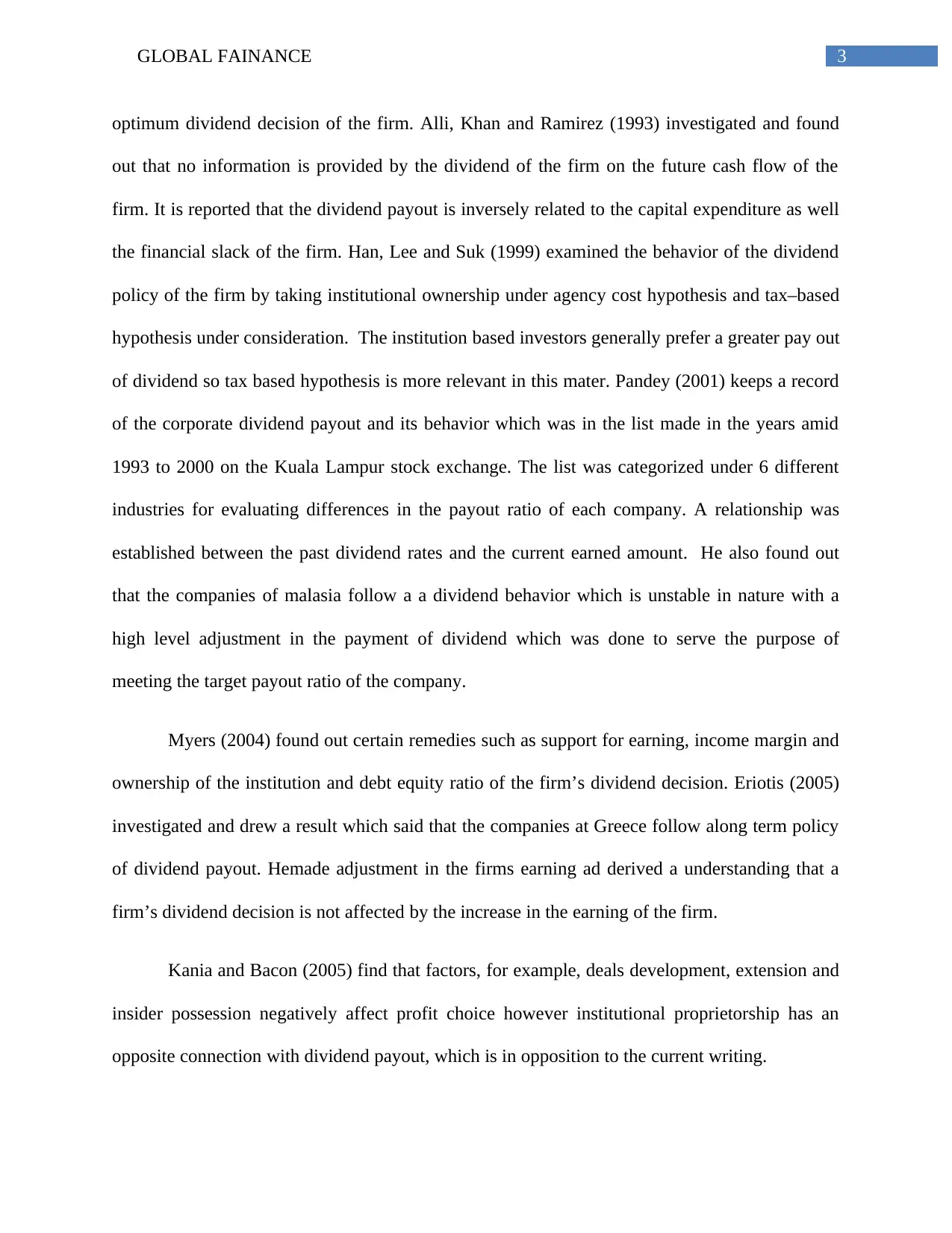
3GLOBAL FAINANCE
optimum dividend decision of the firm. Alli, Khan and Ramirez (1993) investigated and found
out that no information is provided by the dividend of the firm on the future cash flow of the
firm. It is reported that the dividend payout is inversely related to the capital expenditure as well
the financial slack of the firm. Han, Lee and Suk (1999) examined the behavior of the dividend
policy of the firm by taking institutional ownership under agency cost hypothesis and tax–based
hypothesis under consideration. The institution based investors generally prefer a greater pay out
of dividend so tax based hypothesis is more relevant in this mater. Pandey (2001) keeps a record
of the corporate dividend payout and its behavior which was in the list made in the years amid
1993 to 2000 on the Kuala Lampur stock exchange. The list was categorized under 6 different
industries for evaluating differences in the payout ratio of each company. A relationship was
established between the past dividend rates and the current earned amount. He also found out
that the companies of malasia follow a a dividend behavior which is unstable in nature with a
high level adjustment in the payment of dividend which was done to serve the purpose of
meeting the target payout ratio of the company.
Myers (2004) found out certain remedies such as support for earning, income margin and
ownership of the institution and debt equity ratio of the firm’s dividend decision. Eriotis (2005)
investigated and drew a result which said that the companies at Greece follow along term policy
of dividend payout. Hemade adjustment in the firms earning ad derived a understanding that a
firm’s dividend decision is not affected by the increase in the earning of the firm.
Kania and Bacon (2005) find that factors, for example, deals development, extension and
insider possession negatively affect profit choice however institutional proprietorship has an
opposite connection with dividend payout, which is in opposition to the current writing.
optimum dividend decision of the firm. Alli, Khan and Ramirez (1993) investigated and found
out that no information is provided by the dividend of the firm on the future cash flow of the
firm. It is reported that the dividend payout is inversely related to the capital expenditure as well
the financial slack of the firm. Han, Lee and Suk (1999) examined the behavior of the dividend
policy of the firm by taking institutional ownership under agency cost hypothesis and tax–based
hypothesis under consideration. The institution based investors generally prefer a greater pay out
of dividend so tax based hypothesis is more relevant in this mater. Pandey (2001) keeps a record
of the corporate dividend payout and its behavior which was in the list made in the years amid
1993 to 2000 on the Kuala Lampur stock exchange. The list was categorized under 6 different
industries for evaluating differences in the payout ratio of each company. A relationship was
established between the past dividend rates and the current earned amount. He also found out
that the companies of malasia follow a a dividend behavior which is unstable in nature with a
high level adjustment in the payment of dividend which was done to serve the purpose of
meeting the target payout ratio of the company.
Myers (2004) found out certain remedies such as support for earning, income margin and
ownership of the institution and debt equity ratio of the firm’s dividend decision. Eriotis (2005)
investigated and drew a result which said that the companies at Greece follow along term policy
of dividend payout. Hemade adjustment in the firms earning ad derived a understanding that a
firm’s dividend decision is not affected by the increase in the earning of the firm.
Kania and Bacon (2005) find that factors, for example, deals development, extension and
insider possession negatively affect profit choice however institutional proprietorship has an
opposite connection with dividend payout, which is in opposition to the current writing.
Secure Best Marks with AI Grader
Need help grading? Try our AI Grader for instant feedback on your assignments.
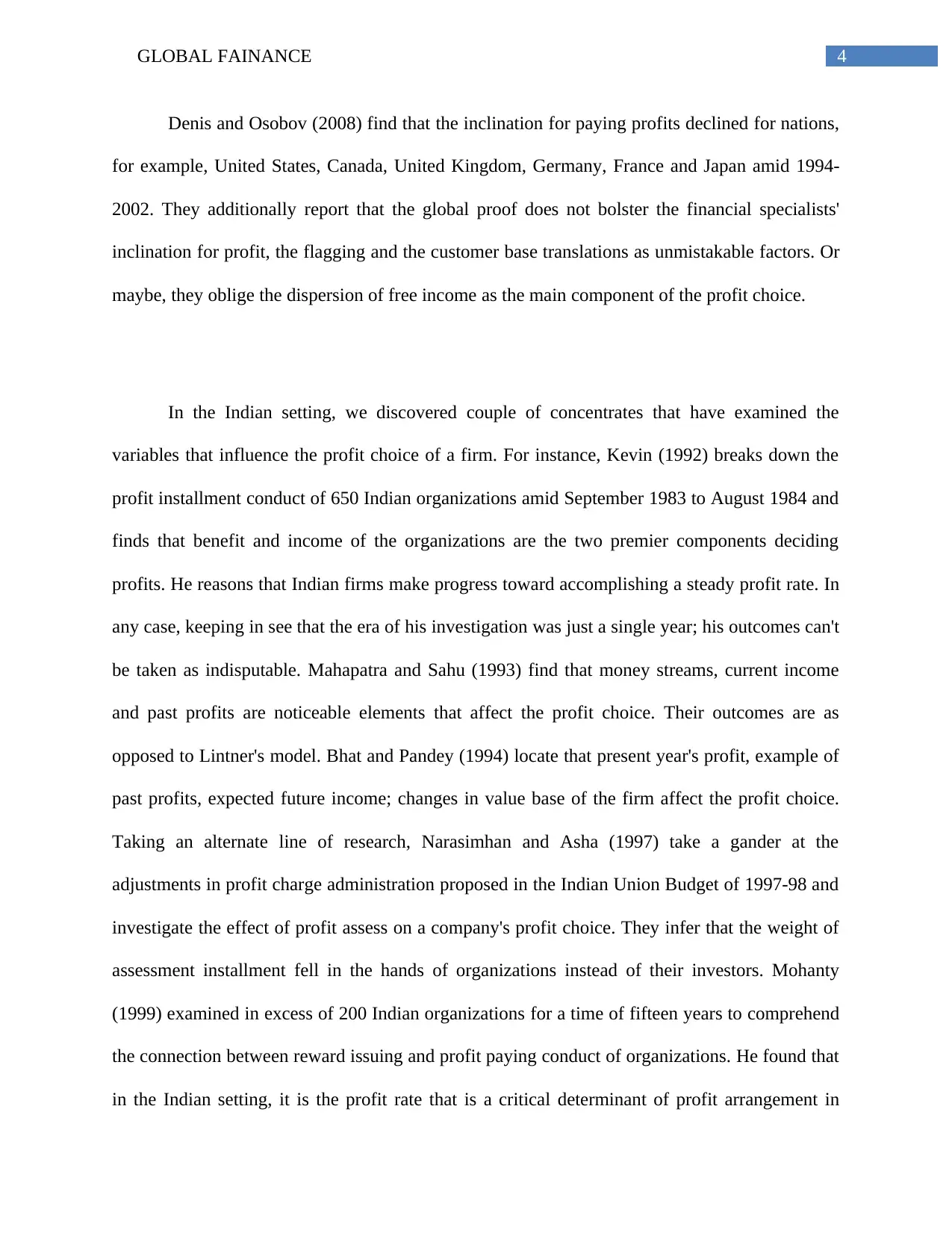
4GLOBAL FAINANCE
Denis and Osobov (2008) find that the inclination for paying profits declined for nations,
for example, United States, Canada, United Kingdom, Germany, France and Japan amid 1994-
2002. They additionally report that the global proof does not bolster the financial specialists'
inclination for profit, the flagging and the customer base translations as unmistakable factors. Or
maybe, they oblige the dispersion of free income as the main component of the profit choice.
In the Indian setting, we discovered couple of concentrates that have examined the
variables that influence the profit choice of a firm. For instance, Kevin (1992) breaks down the
profit installment conduct of 650 Indian organizations amid September 1983 to August 1984 and
finds that benefit and income of the organizations are the two premier components deciding
profits. He reasons that Indian firms make progress toward accomplishing a steady profit rate. In
any case, keeping in see that the era of his investigation was just a single year; his outcomes can't
be taken as indisputable. Mahapatra and Sahu (1993) find that money streams, current income
and past profits are noticeable elements that affect the profit choice. Their outcomes are as
opposed to Lintner's model. Bhat and Pandey (1994) locate that present year's profit, example of
past profits, expected future income; changes in value base of the firm affect the profit choice.
Taking an alternate line of research, Narasimhan and Asha (1997) take a gander at the
adjustments in profit charge administration proposed in the Indian Union Budget of 1997-98 and
investigate the effect of profit assess on a company's profit choice. They infer that the weight of
assessment installment fell in the hands of organizations instead of their investors. Mohanty
(1999) examined in excess of 200 Indian organizations for a time of fifteen years to comprehend
the connection between reward issuing and profit paying conduct of organizations. He found that
in the Indian setting, it is the profit rate that is a critical determinant of profit arrangement in
Denis and Osobov (2008) find that the inclination for paying profits declined for nations,
for example, United States, Canada, United Kingdom, Germany, France and Japan amid 1994-
2002. They additionally report that the global proof does not bolster the financial specialists'
inclination for profit, the flagging and the customer base translations as unmistakable factors. Or
maybe, they oblige the dispersion of free income as the main component of the profit choice.
In the Indian setting, we discovered couple of concentrates that have examined the
variables that influence the profit choice of a firm. For instance, Kevin (1992) breaks down the
profit installment conduct of 650 Indian organizations amid September 1983 to August 1984 and
finds that benefit and income of the organizations are the two premier components deciding
profits. He reasons that Indian firms make progress toward accomplishing a steady profit rate. In
any case, keeping in see that the era of his investigation was just a single year; his outcomes can't
be taken as indisputable. Mahapatra and Sahu (1993) find that money streams, current income
and past profits are noticeable elements that affect the profit choice. Their outcomes are as
opposed to Lintner's model. Bhat and Pandey (1994) locate that present year's profit, example of
past profits, expected future income; changes in value base of the firm affect the profit choice.
Taking an alternate line of research, Narasimhan and Asha (1997) take a gander at the
adjustments in profit charge administration proposed in the Indian Union Budget of 1997-98 and
investigate the effect of profit assess on a company's profit choice. They infer that the weight of
assessment installment fell in the hands of organizations instead of their investors. Mohanty
(1999) examined in excess of 200 Indian organizations for a time of fifteen years to comprehend
the connection between reward issuing and profit paying conduct of organizations. He found that
in the Indian setting, it is the profit rate that is a critical determinant of profit arrangement in
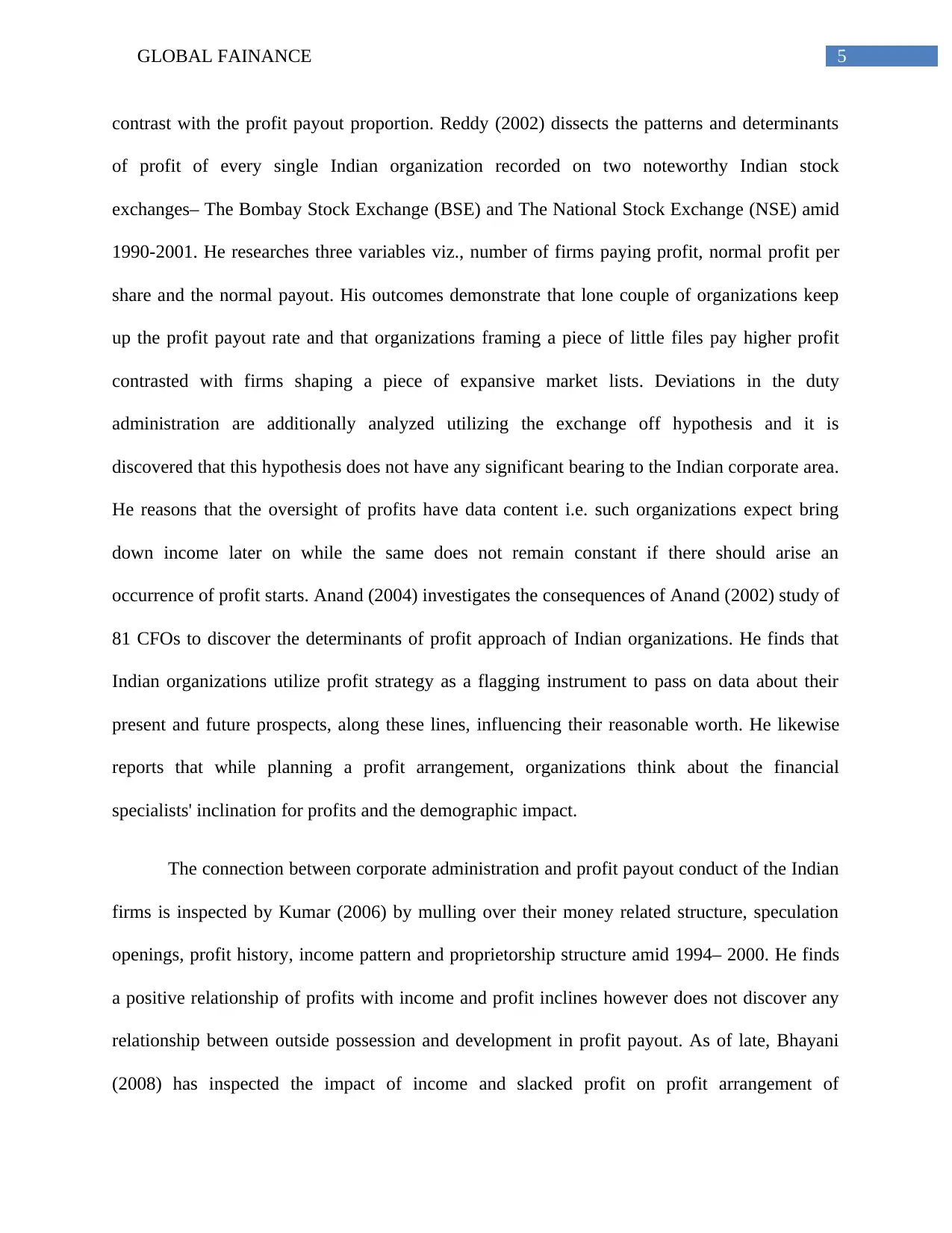
5GLOBAL FAINANCE
contrast with the profit payout proportion. Reddy (2002) dissects the patterns and determinants
of profit of every single Indian organization recorded on two noteworthy Indian stock
exchanges– The Bombay Stock Exchange (BSE) and The National Stock Exchange (NSE) amid
1990-2001. He researches three variables viz., number of firms paying profit, normal profit per
share and the normal payout. His outcomes demonstrate that lone couple of organizations keep
up the profit payout rate and that organizations framing a piece of little files pay higher profit
contrasted with firms shaping a piece of expansive market lists. Deviations in the duty
administration are additionally analyzed utilizing the exchange off hypothesis and it is
discovered that this hypothesis does not have any significant bearing to the Indian corporate area.
He reasons that the oversight of profits have data content i.e. such organizations expect bring
down income later on while the same does not remain constant if there should arise an
occurrence of profit starts. Anand (2004) investigates the consequences of Anand (2002) study of
81 CFOs to discover the determinants of profit approach of Indian organizations. He finds that
Indian organizations utilize profit strategy as a flagging instrument to pass on data about their
present and future prospects, along these lines, influencing their reasonable worth. He likewise
reports that while planning a profit arrangement, organizations think about the financial
specialists' inclination for profits and the demographic impact.
The connection between corporate administration and profit payout conduct of the Indian
firms is inspected by Kumar (2006) by mulling over their money related structure, speculation
openings, profit history, income pattern and proprietorship structure amid 1994– 2000. He finds
a positive relationship of profits with income and profit inclines however does not discover any
relationship between outside possession and development in profit payout. As of late, Bhayani
(2008) has inspected the impact of income and slacked profit on profit arrangement of
contrast with the profit payout proportion. Reddy (2002) dissects the patterns and determinants
of profit of every single Indian organization recorded on two noteworthy Indian stock
exchanges– The Bombay Stock Exchange (BSE) and The National Stock Exchange (NSE) amid
1990-2001. He researches three variables viz., number of firms paying profit, normal profit per
share and the normal payout. His outcomes demonstrate that lone couple of organizations keep
up the profit payout rate and that organizations framing a piece of little files pay higher profit
contrasted with firms shaping a piece of expansive market lists. Deviations in the duty
administration are additionally analyzed utilizing the exchange off hypothesis and it is
discovered that this hypothesis does not have any significant bearing to the Indian corporate area.
He reasons that the oversight of profits have data content i.e. such organizations expect bring
down income later on while the same does not remain constant if there should arise an
occurrence of profit starts. Anand (2004) investigates the consequences of Anand (2002) study of
81 CFOs to discover the determinants of profit approach of Indian organizations. He finds that
Indian organizations utilize profit strategy as a flagging instrument to pass on data about their
present and future prospects, along these lines, influencing their reasonable worth. He likewise
reports that while planning a profit arrangement, organizations think about the financial
specialists' inclination for profits and the demographic impact.
The connection between corporate administration and profit payout conduct of the Indian
firms is inspected by Kumar (2006) by mulling over their money related structure, speculation
openings, profit history, income pattern and proprietorship structure amid 1994– 2000. He finds
a positive relationship of profits with income and profit inclines however does not discover any
relationship between outside possession and development in profit payout. As of late, Bhayani
(2008) has inspected the impact of income and slacked profit on profit arrangement of
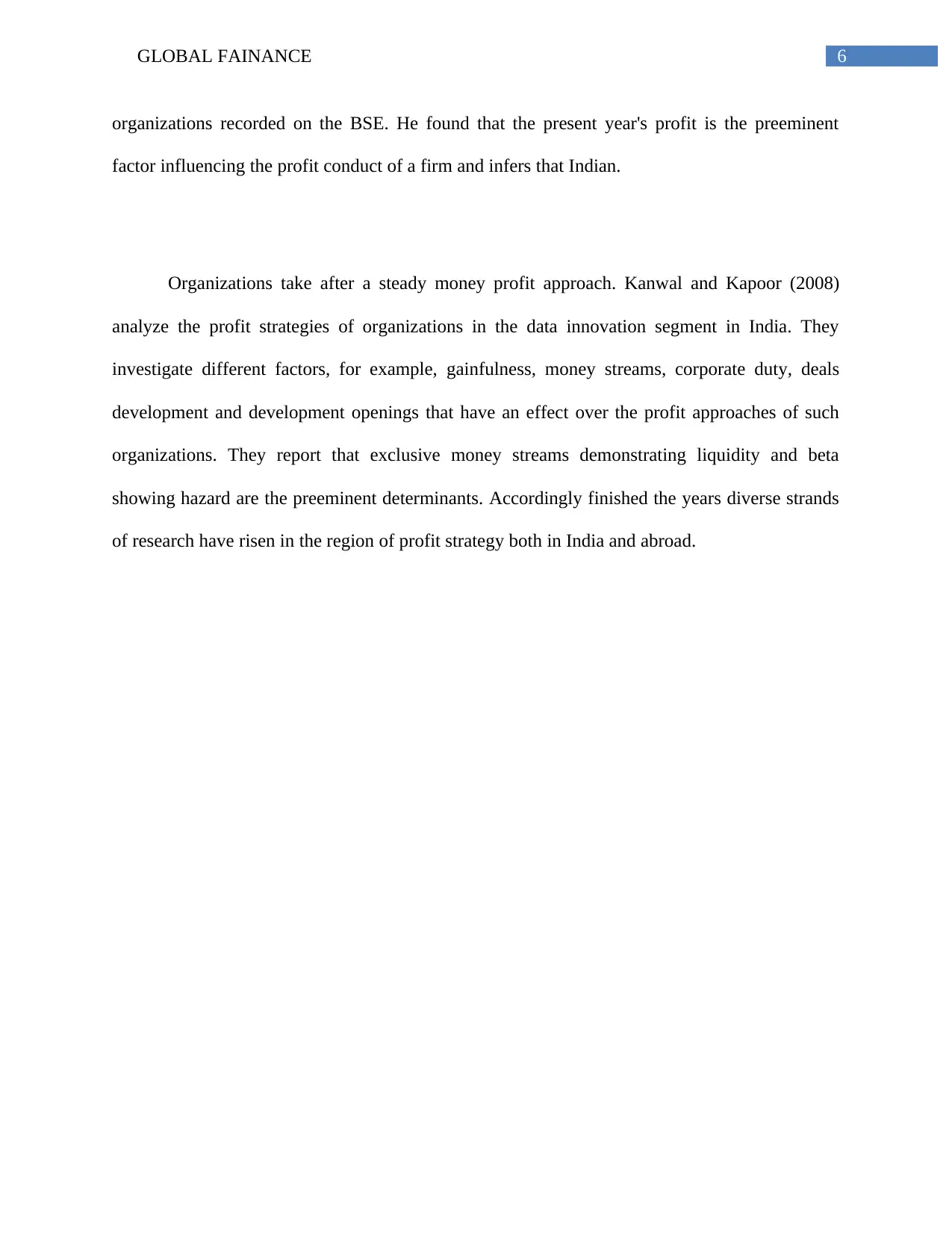
6GLOBAL FAINANCE
organizations recorded on the BSE. He found that the present year's profit is the preeminent
factor influencing the profit conduct of a firm and infers that Indian.
Organizations take after a steady money profit approach. Kanwal and Kapoor (2008)
analyze the profit strategies of organizations in the data innovation segment in India. They
investigate different factors, for example, gainfulness, money streams, corporate duty, deals
development and development openings that have an effect over the profit approaches of such
organizations. They report that exclusive money streams demonstrating liquidity and beta
showing hazard are the preeminent determinants. Accordingly finished the years diverse strands
of research have risen in the region of profit strategy both in India and abroad.
organizations recorded on the BSE. He found that the present year's profit is the preeminent
factor influencing the profit conduct of a firm and infers that Indian.
Organizations take after a steady money profit approach. Kanwal and Kapoor (2008)
analyze the profit strategies of organizations in the data innovation segment in India. They
investigate different factors, for example, gainfulness, money streams, corporate duty, deals
development and development openings that have an effect over the profit approaches of such
organizations. They report that exclusive money streams demonstrating liquidity and beta
showing hazard are the preeminent determinants. Accordingly finished the years diverse strands
of research have risen in the region of profit strategy both in India and abroad.
1 out of 7
Related Documents
Your All-in-One AI-Powered Toolkit for Academic Success.
+13062052269
info@desklib.com
Available 24*7 on WhatsApp / Email
![[object Object]](/_next/static/media/star-bottom.7253800d.svg)
Unlock your academic potential
© 2024 | Zucol Services PVT LTD | All rights reserved.




